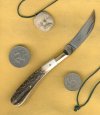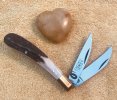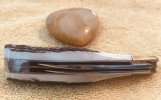BrotherJim
Gold Member
- Joined
- Feb 9, 2015
- Messages
- 4,246
The Edge of Steel: A Quiet Encounter That Might Have Been
The air in the workshop was thick with the hum of machines, the rhythmic tap-tap-tap of hammers, and the scent of oil and steel. In the heart of Sheffield, where cutlery had been forged for centuries, two men stood at the pinnacle of their craft, Trevor Ablett and Graham Clayton. Both had spent decades shaping steel into something more than just tools; they had shaped it into art.
Trevor’s workshop, tucked away in a narrow building off Edmund Road, was filled with the steady buzz of buffing wheels and the clink of hammers striking metal. He’d spent years honing the craft his uncle, Emil Berek, had introduced him to back in 1957, age 15. Folding knives were his specialty. Simple, elegant, and functional, each piece a reflection of his patient, methodical work. His knives were marked with the city’s emblem, a shield with crossed arrows and wheat sheaves, symbolizing the timeless connection between man and steel. But in Trevor’s eyes, it wasn’t just about making knives, it was about making knives that would last a lifetime, knives that felt like they were part of the knife bearer’s story.
Across the city, Graham Clayton was shaping something very different, though no less legendary. He entered the trade in 1959, also age 15. A former apprentice at George Wostenholm, Graham had learned the hard way, enduring long, tiring hours in the factory before branching out to create his own mark on the world. Graham Clayton eventually assumed Fred James’s mantle as Sheffield’s most prolific Bowie knife man. He also made folding knives with intricate designs. His pieces now coveted by collectors across the globe. His workshop was filled with the same materials, ivory, horn, pearl, but each knife told a story of a different kind. More dramatic, more daring, and often, more exotic. His knives weren’t just tools for cutting, they were symbols of strength, adventure, and craftsmanship. Graham had mastered the art of the Bowie during a time when it was rapidly fading, and in doing so, he had cemented himself as one of Sheffield’s finest.
Their paths had crossed many times over the years, at knife fairs, in the workshops of mutual friends, or occasionally at the pub. But there was a quiet rivalry between them. An unspoken acknowledgment that each man’s work was a reflection of the city itself ... gritty, resilient, but with an undeniable beauty that came from the hands of those who knew its history.
Graham, ever the maverick, had taken his knives across the world, selling them in the United States, Australia, and Canada. He had even adopted the trade name “DIGBY’S” to meet the growing demand from collectors across the pond. He also used the trade name “COUTEL”. Trevor, on the other hand, had stayed rooted to his workshop, never once feeling the pull of international fame. His knives were modest in price but sublime in quality. They were made for use, not for display, and his customers appreciated the personal touch that Trevor always put into his work. He often joked, “I’ve never ventured abroad. My travels have been in the steel.”
But despite their differences in approach, both men were driven by the same passion, a love for Sheffield steel and a respect for the generations of craftsmen who had come before them. Their work was not just about profit, it was about preserving a tradition, a legacy that had been handed down through the generations.
One evening, as the sun dipped low over the steel mills, Trevor and Graham met in a small cafe in the city center, a place where the old cutlers still gathered to swap stories. It had been years since they had spoken more than a few words to each other. The tension between them had always been palpable, yet there was an unspoken respect. Over cups of tea, they began to talk about their early days in the trade, about the changes they had seen in the city, and about the knives they had made. Graham spoke of the American market and how he had almost given up on making Bowies until he’d received a letter from a collector in New York. Trevor, with his quiet smile, listened, before speaking of his own customers, the ones who came back year after year for a new knife, always trusting him to make them something that would be with them for decades.
“I’ve always believed in making knives for the hands that use them,” Trevor said, his voice tempered with years of hard work. “Tools, not trophies.”
Graham nodded, his mind already drifting back to the knives he had made for collectors, for the ones who admired them from behind glass. “I’ve always felt the same way,” he said. “But sometimes ... it’s nice to see a knife appreciated from a distance. To know someone looks at it and sees not just the steel, but the history behind it.”
The two men sat in silence for a long moment, the weight of their shared history between them. It wasn’t a rivalry anymore. It was something deeper, something that only those who had spent their lives crafting knives could understand. They were two sides of the same coin, both shaped by the same city, the same craft, the same fire.
As the evening wore on, Trevor and Graham parted ways, each heading back to their workshops. The city of Sheffield, its steel mills and its workshops, seemed quieter that night, as if the very air held its breath, waiting for the next generation of cutlers to emerge from its shadows.
But Trevor Ablett and Graham Clayton knew better. They had done their part. And no matter where the future took the craft, they would always be there, a part of Sheffield’s legacy, shaping steel, shaping knives, and shaping the story of a city that would never forget its masters.

The air in the workshop was thick with the hum of machines, the rhythmic tap-tap-tap of hammers, and the scent of oil and steel. In the heart of Sheffield, where cutlery had been forged for centuries, two men stood at the pinnacle of their craft, Trevor Ablett and Graham Clayton. Both had spent decades shaping steel into something more than just tools; they had shaped it into art.
Trevor’s workshop, tucked away in a narrow building off Edmund Road, was filled with the steady buzz of buffing wheels and the clink of hammers striking metal. He’d spent years honing the craft his uncle, Emil Berek, had introduced him to back in 1957, age 15. Folding knives were his specialty. Simple, elegant, and functional, each piece a reflection of his patient, methodical work. His knives were marked with the city’s emblem, a shield with crossed arrows and wheat sheaves, symbolizing the timeless connection between man and steel. But in Trevor’s eyes, it wasn’t just about making knives, it was about making knives that would last a lifetime, knives that felt like they were part of the knife bearer’s story.
Across the city, Graham Clayton was shaping something very different, though no less legendary. He entered the trade in 1959, also age 15. A former apprentice at George Wostenholm, Graham had learned the hard way, enduring long, tiring hours in the factory before branching out to create his own mark on the world. Graham Clayton eventually assumed Fred James’s mantle as Sheffield’s most prolific Bowie knife man. He also made folding knives with intricate designs. His pieces now coveted by collectors across the globe. His workshop was filled with the same materials, ivory, horn, pearl, but each knife told a story of a different kind. More dramatic, more daring, and often, more exotic. His knives weren’t just tools for cutting, they were symbols of strength, adventure, and craftsmanship. Graham had mastered the art of the Bowie during a time when it was rapidly fading, and in doing so, he had cemented himself as one of Sheffield’s finest.
Their paths had crossed many times over the years, at knife fairs, in the workshops of mutual friends, or occasionally at the pub. But there was a quiet rivalry between them. An unspoken acknowledgment that each man’s work was a reflection of the city itself ... gritty, resilient, but with an undeniable beauty that came from the hands of those who knew its history.
Graham, ever the maverick, had taken his knives across the world, selling them in the United States, Australia, and Canada. He had even adopted the trade name “DIGBY’S” to meet the growing demand from collectors across the pond. He also used the trade name “COUTEL”. Trevor, on the other hand, had stayed rooted to his workshop, never once feeling the pull of international fame. His knives were modest in price but sublime in quality. They were made for use, not for display, and his customers appreciated the personal touch that Trevor always put into his work. He often joked, “I’ve never ventured abroad. My travels have been in the steel.”
But despite their differences in approach, both men were driven by the same passion, a love for Sheffield steel and a respect for the generations of craftsmen who had come before them. Their work was not just about profit, it was about preserving a tradition, a legacy that had been handed down through the generations.
One evening, as the sun dipped low over the steel mills, Trevor and Graham met in a small cafe in the city center, a place where the old cutlers still gathered to swap stories. It had been years since they had spoken more than a few words to each other. The tension between them had always been palpable, yet there was an unspoken respect. Over cups of tea, they began to talk about their early days in the trade, about the changes they had seen in the city, and about the knives they had made. Graham spoke of the American market and how he had almost given up on making Bowies until he’d received a letter from a collector in New York. Trevor, with his quiet smile, listened, before speaking of his own customers, the ones who came back year after year for a new knife, always trusting him to make them something that would be with them for decades.
“I’ve always believed in making knives for the hands that use them,” Trevor said, his voice tempered with years of hard work. “Tools, not trophies.”
Graham nodded, his mind already drifting back to the knives he had made for collectors, for the ones who admired them from behind glass. “I’ve always felt the same way,” he said. “But sometimes ... it’s nice to see a knife appreciated from a distance. To know someone looks at it and sees not just the steel, but the history behind it.”
The two men sat in silence for a long moment, the weight of their shared history between them. It wasn’t a rivalry anymore. It was something deeper, something that only those who had spent their lives crafting knives could understand. They were two sides of the same coin, both shaped by the same city, the same craft, the same fire.
As the evening wore on, Trevor and Graham parted ways, each heading back to their workshops. The city of Sheffield, its steel mills and its workshops, seemed quieter that night, as if the very air held its breath, waiting for the next generation of cutlers to emerge from its shadows.
But Trevor Ablett and Graham Clayton knew better. They had done their part. And no matter where the future took the craft, they would always be there, a part of Sheffield’s legacy, shaping steel, shaping knives, and shaping the story of a city that would never forget its masters.






